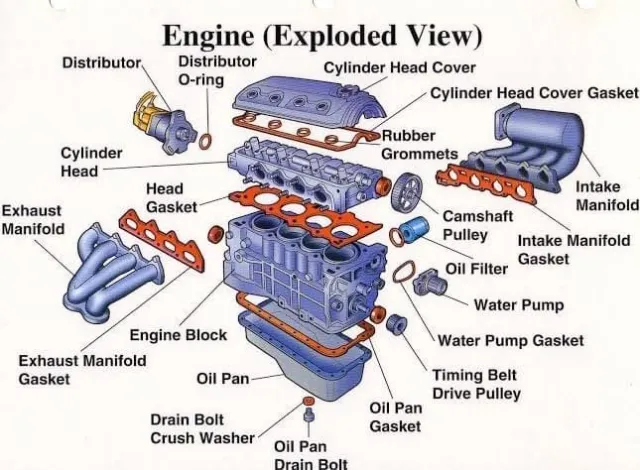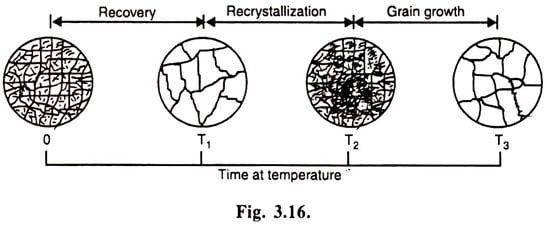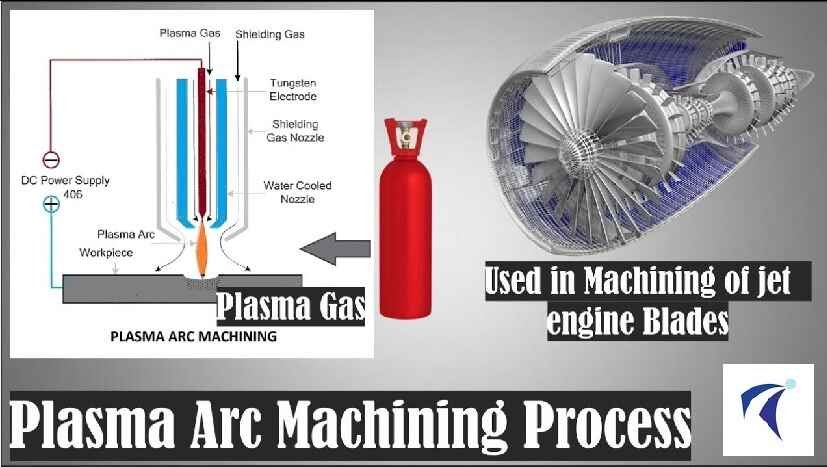what is cylinder head
A cylinder head is an essential component of an internal combustion engine, typically found on top of the engine block. It plays a crucial role in the engine’s operation by sealing the combustion chambers and helping to manage the combustion process.
Cylinder Head Parts or Construction
let’s explore each of these engine components in more detail:

1.Cylinder Block:
- The cylinder block, also known as the engine block, is the core component of an internal combustion engine.
- It houses the engine cylinders where the pistons move up and down during the combustion process.
- Cylinder blocks are typically made of cast iron or aluminum and provide structural support for the engine while containing passages for coolant circulation and oil lubrication.
2.Cylinder Head Gasket:
- The cylinder head gasket is a thin, often multilayered, seal positioned between the cylinder head and the cylinder block.
- Its primary purpose is to create a reliable seal, preventing the escape of combustion gases, engine coolant, and engine oil from the combustion chamber.
- Cylinder head gaskets are designed to withstand high temperatures and pressures.
3.Piston:
- Pistons are cylindrical components that move within the engine cylinders.
- They are typically made of aluminum alloy and are connected to the crankshaft through connecting rods.
- Pistons play a crucial role in converting the force generated by the combustion of air and fuel into linear motion, which ultimately drives the engine.
4.Camshaft:
- The camshaft is a long, cylindrical shaft with lobes or cams placed at specific intervals.
- It is responsible for controlling the opening and closing of the engine’s intake and exhaust valves.
- Camshafts are driven by the engine’s timing system and determine valve timing and duration, impacting engine performance.
5.Valves:
- Valves are metal components located within the cylinder head.
- Intake valves allow the entry of air and fuel into the combustion chamber, while exhaust valves enable the expulsion of burnt gases.
- Valve design and timing are critical factors affecting engine efficiency and power.
6.Valve Spring:
- Valve springs are coil springs that keep the valves closed when not in use and return them to their seats after each opening.
- They ensure proper valve operation by maintaining valve closure and preventing valve float, where the valve fails to close rapidly enough.
7.Spark Plugs:
- Spark plugs are essential components in gasoline engines.
- They create an electrical spark that ignites the air-fuel mixture within the combustion chamber.
- The timing and consistency of spark plug firing directly influence engine performance, efficiency, and emissions.
8.Injector:
- Injectors are found in fuel-injected engines and are responsible for delivering fuel into the combustion chamber.
- They precisely control the timing and amount of fuel injected, ensuring efficient combustion and power generation.
- Modern engines often have multiple injectors for each cylinder.
9.Intake Manifold:
- The intake manifold is a network of passages and chambers that deliver air to the engine’s cylinders.
- It connects the throttle body to the intake ports in the cylinder head.
- The design of the intake manifold affects airflow, fuel-air mixing, and engine performance.
These engine components work together in a precise and coordinated manner to facilitate the combustion process, convert energy into motion, and ultimately power the vehicle or machinery. Their design and functionality vary based on the type of engine (e.g., gasoline, diesel) and specific application.
Cylinder Head Material
Cylinder heads, a critical component of internal combustion engines, are manufactured using various materials to meet specific performance, durability, and heat management requirements. Common materials used for cylinder heads include:
Cast Iron:
- Grey Cast Iron: Historically, grey cast iron was a prevalent choice for cylinder heads due to its excellent heat dissipation properties and durability. It could withstand high temperatures and pressure. However, it is heavier than other materials, making it less common in modern engines.
- Ductile Cast Iron: Ductile cast iron retains the heat dissipation advantages of grey cast iron while offering improved tensile strength and reduced weight. It’s still used in some applications where durability is a top priority.
Aluminum:
- Aluminum Alloy: Aluminum cylinder heads are lightweight and offer efficient heat dissipation, making them popular in modern engines. They contribute to improved fuel efficiency and performance. Aluminum alloys, such as aluminum-silicon and aluminum-magnesium, are commonly used due to their strength-to-weight ratio and thermal conductivity.
Copper:
- Copper Alloy: Copper cylinder heads are rare but have exceptional thermal conductivity properties. They can quickly dissipate heat, but their use is limited to specialized applications due to their high cost and lower mechanical strength compared to other materials.
Composite Materials:
- Aluminum Matrix Composite: Some advanced cylinder heads are made from aluminum matrix composites, which incorporate ceramic materials like silicon carbide. These composites offer a balance of lightweight construction and excellent heat resistance, making them suitable for high-performance applications.
Bimetallic Materials:
- Combination of Aluminum and Cast Iron: In certain engines, a bimetallic construction is used, with an aluminum cylinder head mated to a cast iron engine block. This approach combines the advantages of aluminum’s heat dissipation and weight savings with cast iron’s durability.
The choice of cylinder head material depends on various factors, including the engine’s intended use, cost considerations, and the desired balance between weight, heat management, and durability. Modern engines often employ aluminum alloy cylinder heads for their ability to strike a balance between performance and efficiency while meeting stringent emission standards. However, in applications where extreme durability or specialized heat dissipation is required, alternative materials or hybrid designs may be chosen.
types of cylinder head
Certainly, here’s a more extensive elaboration on each cylinder head type, providing an even deeper understanding of their characteristics and significance:
- Loop Flow Types:
Cylinder heads featuring loop flow designs represent an intriguing historical relic in engine technology. In this configuration, both the intake and exhaust ports are strategically positioned on the same side of the cylinder head, creating a somewhat circuitous or looping path for airflow and exhaust gases within the engine. While this design may appear antiquated and less efficient when compared to more contemporary layouts, it played a crucial role in early engine development. These cylinder heads are a testament to the evolution of engine design, reflecting a time when optimizing air and exhaust flow was less prioritized than it is today. - Offset Cross-Flow Types:
Offset cross-flow cylinder heads stand as a testament to the continuous pursuit of optimizing engine efficiency. These meticulously engineered cylinder heads feature a deliberate offset between the intake and exhaust ports, ensuring that incoming air and outgoing exhaust gases follow distinct and separate pathways. This ingenious arrangement minimizes interference between the two flows, resulting in significantly improved combustion efficiency. The offset design is particularly favored in engines where the precise management of airflow is paramount, such as high-performance and racing engines. - In-Line Cross-Flow Types:
In-line cross-flow cylinder heads epitomize a symmetrical and streamlined approach to optimizing airflow within an engine. With both intake and exhaust ports aligned in a straight line across the cylinder head, this design efficiently channels air and exhaust gases through the engine’s combustion chamber. The deliberate in-line arrangement enhances combustion efficiency and power generation, making it a preferred choice for modern engines that prioritize maximizing airflow and achieving superior fuel efficiency. The symmetrical alignment ensures a balanced flow of gases, contributing to consistent and high-performance engine operation. - Water-Cooled Engine:
Engines equipped with water-cooling systems exhibit a sophisticated approach to managing operating temperatures. Within these engines, the cylinder head plays a pivotal role, housing an intricate network of passages for the circulation of a liquid coolant, typically a mixture of water and antifreeze. These passages facilitate the efficient transfer of heat away from critical engine components, including the combustion chamber, cylinder walls, and the cylinder head itself. Water-cooled engines have become the norm in the automotive industry and various industrial applications, thanks to their ability to provide precise temperature control and consistent engine performance across a wide range of environmental conditions. - Air-Cooled Engine:
The concept of air-cooled engines harks back to an era when simplicity and ruggedness were prized attributes in engine design. These engines diverge from the conventional water-cooling approach, forgoing liquid coolant passages within the cylinder head. Instead, they rely solely on natural airflow and the ingenious use of finned surfaces to dissipate the heat generated during combustion. The cylinder head in an air-cooled engine lacks the intricate coolant passages found in water-cooled counterparts, opting for an abundance of fins to enhance heat dissipation. This design is often associated with vintage motorcycles and certain small aircraft engines. While celebrated for their simplicity and durability, air-cooled engines may face challenges under high-temperature or heavy-duty conditions, where heat management becomes critical. - Flathead Cylinder Head:
The flathead cylinder head represents a fascinating chapter in the history of engine design. Recognized by its one-piece, horizontally flat configuration, this design places the valves within the engine block itself rather than within the cylinder head, as seen in modern engine layouts. Flathead engines are emblematic of early automotive engineering, admired for their mechanical simplicity and resilience. However, their performance potential is often limited due to constrained airflow and less-than-optimal combustion characteristics arising from the placement of valves within the engine block. - Overhead-Valve Cylinder Head:
Cylinder heads featuring overhead-valve designs embody a classic and time-tested approach to valve operation. In this configuration, the valves are situated within the cylinder head, with valve actuation achieved through a system of pushrods and rocker arms. Renowned for their robustness and versatility, overhead-valve engines have carved a niche in a wide array of applications, spanning from passenger vehicles to industrial machinery. These engines have earned their reputation for reliability and longevity, albeit with some trade-offs, particularly in high-rev performance, where more advanced designs may have an edge. - Overhead Camshaft Cylinder Head:
The realm of overhead camshaft cylinder heads represents a pinnacle of modern engine design, characterized by precision and efficiency. In this configuration, the camshaft or camshafts are ingeniously integrated directly within the cylinder head itself. This design affords unparalleled control over valve timing and lift, a characteristic highly prized in high-revving and high-performance engines. Overhead camshaft designs have gained prominence in contemporary engine technology, thanks to their exceptional capacity to optimize valve operation, combustion efficiency, and power output. Moreover, they contribute significantly to enhanced fuel economy, setting the stage for engines that excel in both performance and efficiency.
These diverse cylinder head types constitute a captivating tapestry of engine design, each bearing its unique characteristics and playing a pivotal role in shaping an engine’s performance, efficiency, and cooling prowess. The selection of a particular cylinder head design hinges on an array of factors, including the specific requirements of the application, the desired performance attributes, and the overarching goals of the engine designer.
according to arrangement of inlet and exhaust valve
Certainly, based on the arrangement of inlet and exhaust valves in the cylinder head or block of an engine, automobile engines are commonly classified into four categories: ‘L’ head, ‘I’ head, ‘F’ head, and ‘T’ head.
- L Head (L-Head):
In an ‘L’ head engine, both the intake and exhaust valves are located on one side of the engine, typically in the engine block. This configuration creates an ‘L’ shape when viewed from the side, hence the name. ‘L’ head engines are known for their simplicity and were commonly used in early automotive designs. However, they are less efficient in terms of airflow and combustion compared to more modern engine designs. - I Head (I-Head):
An ‘I’ head engine, also known as an inline head, has its intake and exhaust valves aligned in a straight line on the same side of the cylinder head. This design optimizes the flow of air and exhaust gases through the engine, making it more efficient than ‘L’ head engines. ‘I’ head configurations are commonly found in modern engines, as they improve combustion efficiency and power output. - F Head (F-Head):
‘F’ head engines, also known as flathead engines, combine features of both ‘L’ and ‘I’ head designs. These engines have the intake valves located in the cylinder head while the exhaust valves are in the engine block. This hybrid configuration was used in some older engines and attempted to strike a balance between simplicity and improved airflow. However, ‘F’ head engines are less common in modern automotive design. - T Head (T-Head):
‘T’ head engines, also called T-shaped head engines, have both the intake and exhaust valves positioned on opposite sides of the engine, forming a ‘T’ shape. This design allows for efficient airflow and exhaust gas removal. ‘T’ head engines were popular in early automotive history, particularly in high-performance and luxury cars, due to their ability to achieve excellent performance and smooth operation.
These classifications based on valve arrangement provide valuable insights into the design and performance characteristics of various engines. Each type has its own advantages and limitations, and the choice of configuration depends on the specific requirements and goals of the engine design.
applications of cylinder head
A cylinder head is a crucial component of an internal combustion engine, and its primary function is to seal the top of the engine’s cylinders. It plays a vital role in the engine’s overall operation and performance. Here are some key applications and functions of a cylinder head:
- Sealing the Combustion Chamber: The cylinder head forms a tight seal at the top of each cylinder, enclosing the combustion chamber. This seal is essential to prevent the escape of gases and maintain compression within the cylinder during the combustion process.
- Mounting Point for Valves: Cylinder heads contain openings and seats for intake and exhaust valves. These valves control the flow of air and exhaust gases in and out of the cylinders. The cylinder head provides a platform for the valves to operate and seal properly.
- Coolant Passages: Many cylinder heads have coolant passages that allow the circulation of coolant to help regulate the engine’s temperature. These passages help dissipate heat generated during combustion, preventing the engine from overheating.
- Spark Plug Mounting: Spark plugs are mounted in the cylinder head, and they ignite the air-fuel mixture in the combustion chamber to initiate the power stroke in the engine.
- Camshaft Mounting: The cylinder head often includes a camshaft and associated components, such as camshaft lobes and lifters. These control the opening and closing of the intake and exhaust valves, regulating the engine’s air and fuel intake and exhaust.
- Combustion Chamber Design: Cylinder heads can be designed with different shapes and configurations to optimize combustion efficiency, power output, and emissions performance. These designs are essential for achieving specific engine performance goals.
- Emission Control: Modern cylinder heads may incorporate features like exhaust gas recirculation (EGR) passages or provisions for mounting emissions control devices to meet environmental regulations.
- Performance Enhancement: Enthusiasts and racing applications often modify cylinder heads to improve airflow, increase compression, and enhance engine performance. Porting and polishing are common techniques used to optimize the design for better efficiency and power output.
- Noise Reduction: Some cylinder heads have features to reduce engine noise, such as integrated noise-reducing baffles or chambers that help mitigate the sound produced during combustion.
- Durability and Strength: Cylinder heads need to withstand high temperatures and pressures. They are typically made from robust materials like aluminum or cast iron to ensure durability and longevity.
In summary, the cylinder head is a critical component in internal combustion engines, serving multiple functions that include sealing the combustion chamber, housing valves, managing coolant flow, and contributing to the overall performance and efficiency of the engine. Its design and features can vary based on the specific application and requirements of the engine.
advantages of cylinder head
Cylinder heads offer several advantages in internal combustion engines and other applications where they are used. Here are some of the key advantages of cylinder heads:
- Combustion Chamber Design: Cylinder heads provide a controlled environment for the combustion process. Their design allows for the precise shaping of the combustion chamber, optimizing the air-fuel mixture and promoting efficient combustion. This leads to improved power output and fuel efficiency.
- Valve Control: Cylinder heads house the intake and exhaust valves, allowing for precise control over the timing and duration of valve opening and closing. This control is essential for managing the flow of air and exhaust gases, optimizing engine performance, and reducing emissions.
- Heat Dissipation: It is typically made of materials that can withstand high temperatures. They help dissipate heat generated during combustion away from the combustion chamber, preventing overheating and engine damage.
- Sealing: Cylinder heads seal the top of the engine cylinders, preventing the escape of combustion gases and ensuring that compression is maintained. Proper sealing is crucial for engine efficiency and preventing power loss.
- Weight Reduction: In comparison to a single-piece engine block, cylinder heads can be designed to be lighter, contributing to overall weight reduction in the engine. This can improve vehicle fuel efficiency and handling.
- Component Integration: Modern cylinder heads often incorporate various components, such as spark plug ports, fuel injectors, and sensors, which streamline engine assembly and reduce complexity.
- Durability: It is constructed from robust materials like aluminum or cast iron, ensuring longevity and resistance to wear and tear.
- Reduced Noise and Vibration: It play a role in dampening engine noise and vibrations, contributing to a smoother and quieter engine operation.
- Improved Cooling: Some cylinder head designs incorporate cooling channels or passages for coolant flow. This helps maintain consistent engine temperature, preventing overheating and engine damage.
- Customization: It can be customized and designed for specific performance requirements, making them suitable for a wide range of applications, from economy vehicles to high-performance racing engines.
- Emission Control: Cylinder heads contribute to emission control by aiding in the efficient combustion of fuel, reducing harmful emissions and meeting environmental regulations.
- Repair and Maintenance: Cylinder heads are designed to be removable and replaceable, making it easier and more cost-effective to perform maintenance and repairs when necessary.
In summary, cylinder heads are integral components of internal combustion engines, providing a range of advantages that include improved combustion efficiency, precise valve control, heat management, durability, and customization options. These advantages collectively contribute to better engine performance, fuel efficiency, and overall reliability in various applications.
Disadvantages of cylinder head
While cylinder heads offer numerous advantages in internal combustion engines, they also come with some potential disadvantages or challenges. Here are some of the disadvantages associated with cylinder heads:
- Complexity: It is intricate components with various parts, including valves, valve springs, camshafts, and coolant passages. This complexity can make manufacturing, assembly, and maintenance more challenging and expensive.
- Heat-Related Issues: It is exposed to high temperatures during engine operation, which can lead to heat-related problems such as warping, cracking, or degradation of gaskets and seals. These issues can be costly to repair.
- Maintenance Costs: Servicing or replacing a cylinder head can be expensive and labor-intensive, especially in engines where the cylinder head needs to be removed for access.
- Weight: Cylinder heads can add weight to an engine, which can be a disadvantage in applications where weight reduction is a priority, such as racing or aviation.
- Limited Valve Size: The size of valves that can be accommodated in a cylinder head is constrained by the available space. This limitation can restrict the engine’s ability to breathe efficiently at high RPMs, potentially limiting performance in certain applications.
- Valve Train Complexity: The valve train components, including camshafts, rocker arms, and valve lifters, add complexity to the engine. Maintaining and tuning these components can be time-consuming.
- Limited Cooling Efficiency: While cylinder heads often have cooling passages, they may not be as effective at heat dissipation as other engine components like the engine block. This can lead to localized hotspots and thermal stress.
- Risk of Detonation: In engines with high compression ratios, the design of the cylinder head can contribute to the risk of detonation (premature and uncontrolled combustion). Detonation can damage the engine and reduce efficiency.
- Emission Control Challenges: Achieving stringent emission standards can be more challenging with certain cylinder head designs. Proper emission control may require additional components and complexity.
- Compatibility with Alternative Fuels: Some cylinder head materials and designs may not be fully compatible with alternative fuels, such as ethanol or hydrogen, leading to corrosion or combustion issues.
- Vibration and Noise: Vibrations and noise generated by the valve train and other components in the cylinder head can affect engine smoothness and driver comfort.
- Limited Airflow at Low RPM: In some cases, cylinder heads designed for high-performance at high RPMs may not provide optimal airflow and torque at low RPMs, affecting drivability in everyday vehicles.
It’s important to note that many of these disadvantages can be mitigated or addressed through engineering, design improvements, and proper maintenance. Cylinder heads are a critical component of internal combustion engines, and their advantages typically outweigh these potential drawbacks, especially when designed and maintained effectively for a specific application.
The cylinder covers/cylinder head forms the top part of the combustion space and it must be of suffucient strength to withstand the gas load at maximum pressure.
The primary function of the cylinder cover is to close the end of the cylinder and to seal the gases involving extreme pressure and temperatures.The cover is exposed to high mechanical and thermal stresses.
Material used:- pearlitic or Nodular Graphite Cast Iron/Cast iron.
The cover lands on the top of the cylinder liner flange and is secured to the cylinder block by a number of cover studs and nuts.These are tightened hydraulically.
The covers also support various mountings and all the valve required to maitain the engine
In a two stroke large engine ,there may be large central exhaust valve,and cage ,2 or 3 fuek injectir,a starting valve,rekief valve &an indicator cock.
Medium speed 4 stroke diesel engines have two exgaust valve and two air inlet valve per cylindee,one centrally olaced fuel injector,an air starting valve,rekief valve,and indicator cock.
Properties:-
1.it should transfer heat readily
2.resist bending
3.be symmetrical in shape
4.have coefficient of thermal expansion
Similar to liner.
They are circulated with fresh water from the jacket cooling system which maintains moderate temperatures and allows intensive cooling of the exhaust valve seating while making seoerate fuel valve cooling unnecessary.
Bore cooling arrangement are provided in modern cylinder covers,generally made up of cast steel.
How Cylinder Head is Manufactured or Manufacturing process
The manufacturing process of a cylinder head is a complex and precise series of steps that involve shaping, machining, and assembling various components. Below is an overview of the typical manufacturing process for a cylinder head:
- Material Selection:
The process begins with the selection of the appropriate material for the cylinder head. As mentioned earlier, common materials include cast iron, aluminum, and aluminum alloys, depending on the engine’s requirements. - Casting:
For most cylinder heads, the initial step is casting. This involves creating a mold of the cylinder head’s shape, usually made from sand or a similar material. Molten metal is then poured into the mold and allowed to cool and solidify. The result is a rough casting of the cylinder head’s shape, often referred to as a “raw casting.” - Core Insertion:
In some cases, core inserts made of sand or other materials are used to create internal passages and chambers within the cylinder head. These inserts are positioned in the mold before casting and are removed after the casting has cooled, leaving behind the desired internal shapes. - Machining:
The raw casting is then subjected to various machining operations to refine its shape and dimensions. This includes milling, drilling, and boring to create precise surfaces for mating with other engine components, such as the engine block, gaskets, and valves. - Valve Seat Installation:
Valve seats, which are crucial for proper sealing and combustion, are often installed in the cylinder head. These seats are either pressed or machined into place, and then they are precision-ground to ensure an airtight seal with the engine’s valves. - Valve Guide Installation:
Valve guides, which provide support and guidance for the engine’s valves, are installed into the cylinder head. These guides may be made of materials like bronze or cast iron and are either press-fitted or machined into place. - Surface Finishing:
The cylinder head’s mating surfaces are carefully finished to ensure a proper seal with the engine block and other components. This involves milling or grinding to achieve the required surface roughness and flatness. - Assembly:
Once all machining and finishing operations are complete, it is is assembled with other components. This includes attaching the valves, valve springs, and other valve train components. Gaskets and seals are also installed to prevent oil and coolant leaks. - Quality Control:
Throughout the manufacturing process, quality control measures are taken to ensure that the cylinder head meets strict specifications and tolerances. This involves inspections, measurements, and testing to verify the integrity and performance of the finished cylinder head. - Final Inspection and Testing:
Before the cylinder head is shipped to the engine assembly line, a final inspection and testing process is carried out. This may involve pressure testing to check for leaks, measuring critical dimensions, and conducting visual inspections to ensure the cylinder head meets all quality standards.
The manufacturing process for a cylinder head is a combination of advanced machining techniques, precise assembly procedures, and strict quality control measures. Each step is critical to producing a component that plays a vital role in the efficient and reliable operation of an internal combustion engine.
Reference : https://en.wikipedia.org/wiki/Cylinder_head




